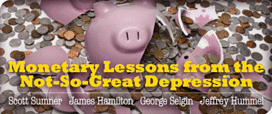Lead Essay
In this month’s sure-to-be controversial lead essay, Bentley University economist Scott Sumner argues that almost everything economists and economic policymakers thought they knew about the role of monetary policy in the recent recession and financial collapse is wrong. Sumner contends that the resources of monetary policy were not exhausted, as many economists believed, but were barely used. Flying in the face of conventional wisdom, Sumner maintains that monetary policy in the run-up to the finacial crisis was not highly expansionary, but was in fact disastrously contractionary. Sumner offers a short history of monetary economics to put into historical perspective the role of allegedly failed monetary policy in the financial crisis and recession. He proposes a strategy for central bankers — targeting forecasts of nominal GDP — that might help avert future crises. In conclusion, Sumner warns of the political dangers of misdiagnosing the crisis: unless the record is set straight, free markets will once again take the fall for a failure of monetary policy.
Response Essays
University of California, San Diego economist James D. Hamilton disputes Scott Sumner’s claim that the sub-prime crisis was a fluke with few lessons for macroeconomics. According to Hamilton, the booming U.S. housing market represented a “huge misdirection of capital,” and the overexposure of key financial institution to the housing market’s downward correction crippled lending and sent the economy into a nosedive. Hamilton agrees that the Fed might have limited the damage had it kept the growth rate for nominal GDP higher, but he disagrees with Sumner about the tools available to the Fed to achieve this. Hamilton notes that tools available to the Fed depend on which of the possible specifications of the money supply and its velocity actually determine nominal GDP. Hamilton says unconventional paths to monetary stimulus were open the Fed in late 2008 and that “the preferred policy … would have been to acknowledge more aggressively the losses financial institutions had absorbed on existing loans, impose those losses on stockholders, creditors, and taxpayers, and retain as the Fed’s first priority the stimulus of nominal GDP rather than trying to lend to everybody.” Hamilton concludes with some worries about Sumner’s favored tool for targeting nominal GDP growth.
University of Georgia economist George Selgin agrees with Scott Sumner that “tight money was the proximate cause of the post-September 2008 recession” and that “a policy of nominal income growth targeting might have prevented the recession.” Selgin encourages Sumner to acknowledge the role easy money played in the subprime crisis, and argues that Sumner’s five-percent nominal income growth target is “unnecessarily and perhaps dangerously high.” Selgin favors a two or three percent target, which he contends would be less likely to perpetuate boom-bust cycles.
San Joses State’s Jeffrey Rogers Hummel begins with a brief history of economic thought about the causes of the business cycle, which leads to a call for “a measure of epistemic humility.” Hummel signs on to much of Sumner’s story about the Fed behavior in 2008, and accepts his criticism of the widespread use of interest rates as the main indicator of monetary policy. But Hummel departs sharply from Sumner’s prescription for better monetary policy — a rule to target the forecast of nominal GDP growth. “The … critical defect of Sumner’s Rule,” Hummel argues, “is its blithe assumption that money, unlike any other good or service, requires not merely government provision but detailed, sophisticated, and flexible government management.” Hummel raises doubts that even the best such rule would be well-applied, and calls for the “abolition of the Fed, elimination of government fiat money, and complete deregulation of banks.”

